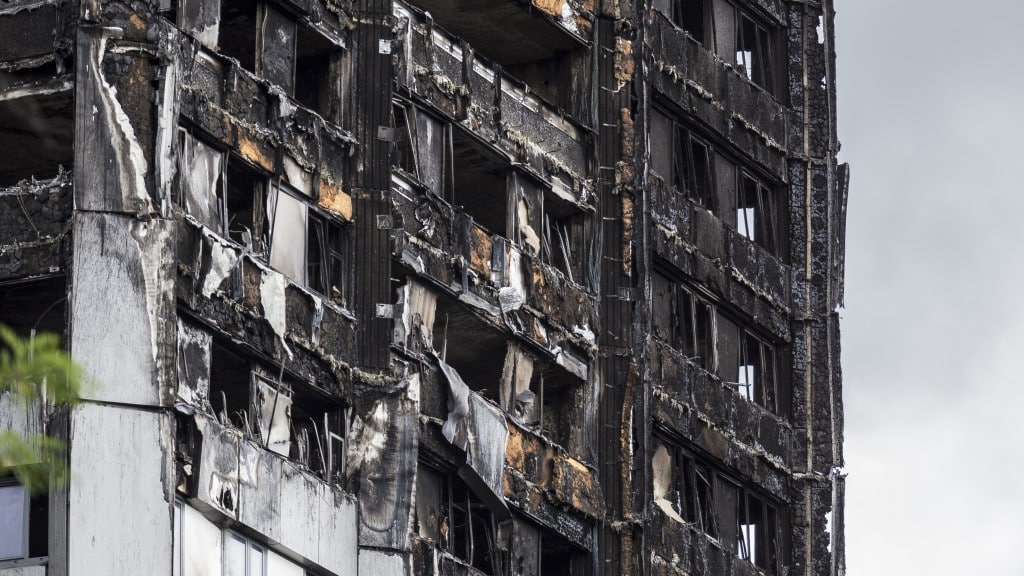Valencia fire prompts investigation into building cladding
- March 4, 2024
- 10:33 am


Iain Hoey
Share this content
Image: Grenfell Tower 2017 (Shutterstock)
The Valencia Fire and Cladding Controversy: Initial Reports and Rebuttals
The fire in Valencia on 22 February 2024, which engulfed two 14-story residential blocks, has raised serious concerns about the materials used in the building’s cladding.
Initial reports suggested the presence of polyurethane insulation, but recent statements from authoritative bodies have contested this claim.
The Modern Building Alliance expressed deep regret over the incident and extended sympathies to those affected.
They noted early media reports citing polyurethane insulation but highlighted that the Vice-President of the College of Industrial Technical Engineers of Valencia and the Technical Architecture School of Valencia have dismissed this hypothesis.
The Alliance stated: “We hope that the investigation will clarify, as quickly as possible, the exact circumstances of the fire and why it spread through the façade so quickly.”
Rigid Polyurethane Industry Association Responds to Cladding Speculations
The Rigid Polyurethane Industry Association (IPUR) also addressed the issue, offering condolences and support to those affected.
They confirmed that there is no evidence of polyurethane in the building’s ventilated façade, neither as a filler for exterior cladding nor as insulation in the air chamber.
The property manager, after consulting the Building Book, corroborated this, stating that the insulating product was not polyurethane.
IPUR said it is ready to assist authorities with expert evidence to confirm the absence of polyurethane.
They emphasised the value of polyurethane insulation in various applications, highlighting its thermal insulation properties.
The Building’s ‘Ventilated Façade’ and its Role in the Fire
The structure of the building, completed in 2009, featured a ‘ventilated façade’, designed for thermal and acoustic insulation.
This system includes a wall, an insulating layer, and a cladding material fixed with an exterior structure, creating an air chamber for ventilation.
The rapid spread of the fire, fuelled by intense winds, was unprecedented, according to Raúl Esteban, Fire Chief of the Alcorcón City Council (Madrid).
Esther Puchades, Vice President of Cogitival and member of Apcas, initially suggested a polyurethane coating but later retracted, citing the possibility of a thermoplastic material added to the rock wool and aluminium.
Current Status of the Investigation and Building Safety Considerations
The investigation is ongoing, with various experts contributing their insights.
Fbex, the developer of the buildings, had used an ‘Alucobond-type’ material, consisting of aluminium sheets and a mineral polymer interior.
The exact composition of this material is yet to be confirmed.
The rapid horizontal spread of the fire also indicates the presence of synthetic floors, as noted by David Higuera, a technical engineer.
The incident draws parallels to the Grenfell Tower fire in London, where flammable plastic cladding significantly contributed to the disaster’s severity.
IFSJ Comment
The Valencia fire tragedy highlights the critical need for thorough investigation and clarity regarding the materials used in building construction.
The ongoing debate over the cladding’s composition underscores the importance of stringent safety standards and transparent reporting of construction materials.
This incident serves as a stark reminder of the potential hazards associated with certain building materials and the necessity for rigorous fire safety measures in high-rise structures.
As the investigation continues, it is imperative that the construction industry and regulatory bodies work together to ensure the safety of residential buildings and their occupants.



